AC Milan have appointed Sérgio Conceição as their new head coach, ushering in a new era at San Siro. After years of success with FC Porto, the Portuguese tactician arrives with a reputation for intense pressing, disciplined defensive structures, and rapid attacking transitions. His aggressive, high-energy approach could redefine Milan’s playing style, bringing a more combative and direct edge to their performances.
In this analysis, we will break down Conceição’s tactical philosophy, examining how his pressing schemes, attacking principles, and in-game adaptability could shape Milan’s future. How will his ideas translate to Serie A? What adjustments will he need to make with the current squad? Let’s take a closer look at what to expect from Milan under Conceição.
Build-up
In the build-up, Conceição primarily sets his team up in a 1-4-3-3 formation, with a back four, one number-six, two number-eights, and a front three.
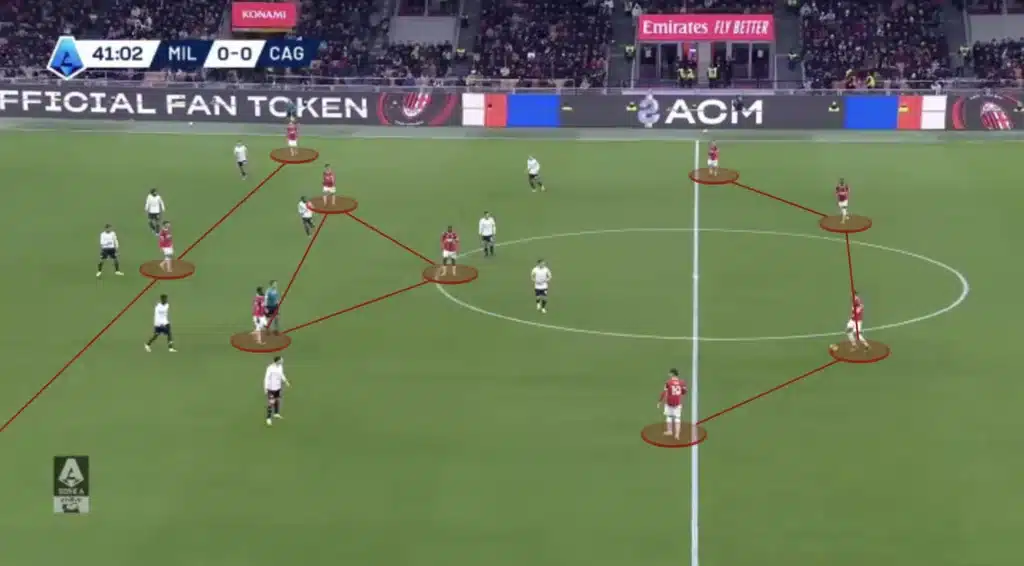
Building up in a 1-4-3-3 formation focuses on creating a solid foundation at the back while maintaining fluidity and options in the midfield. The formation begins with four defenders, who provide width and stability, allowing for controlled possession from deep areas. The single defensive midfielder connects the defense to the midfield, dictating the tempo and distributing the ball to the two more advanced central midfielders. These midfielders position themselves to exploit spaces between the opposition’s lines, creating passing triangles that facilitate smooth progression up the pitch. The three forwards, with the central striker as the focal point, are always ready to receive the ball, either through direct passes or by making runs behind the defense. This setup allows the team to transition quickly from attack to defense, maintaining pressure on the opponent while ensuring defensive coverage.
Wingers Inverting
Milan’s wingers play a key role in Sérgio Conceição’s tactical setup by frequently inverting, which adds a unique layer of fluidity to their attack. Rather than staying wide, they come inside to occupy the half-spaces, positioning themselves between the opposition’s fullbacks and center-backs. This movement pulls defenders out of position, opening up central areas for quick passing combinations and creating space for overlapping fullbacks on the outside. By inverting, the wingers also provide additional support in the middle of the field, allowing Milan to create numerical superiorities in central zones.
Additionally, when the wingers drift inside to occupy central spaces, the fullbacks are encouraged to push up high and wide. This movement stretches the opposition defense, opening up passing lanes and creating opportunities for crosses from the flanks.
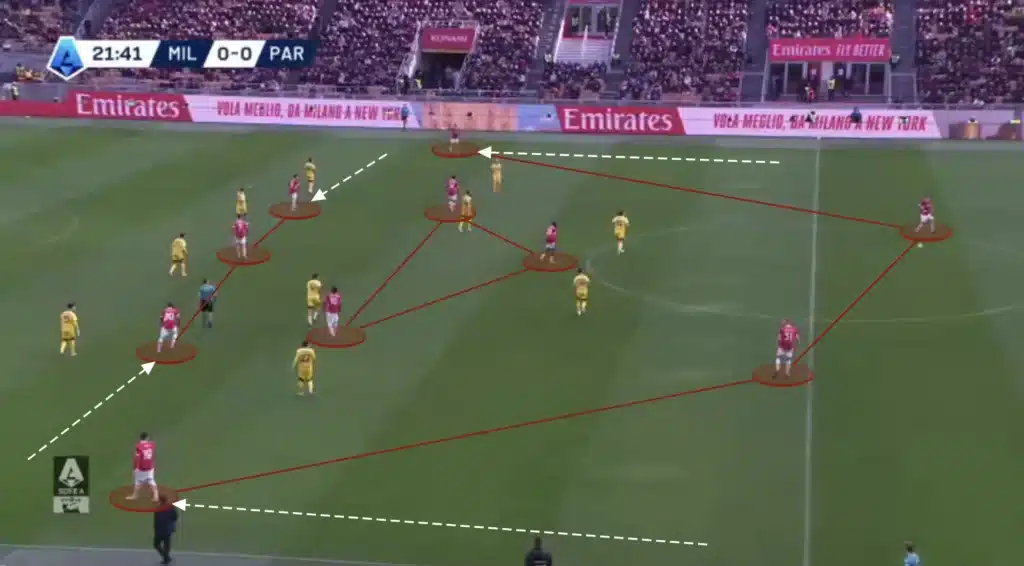
When the wingers invert, the opposition fullbacks usually follow inside, opening the space out wide. The idea of Conceição’s system is then to exploit this space with the fullback, who can drive the ball past the opposition’s midfield line, getting into more advanced positions.
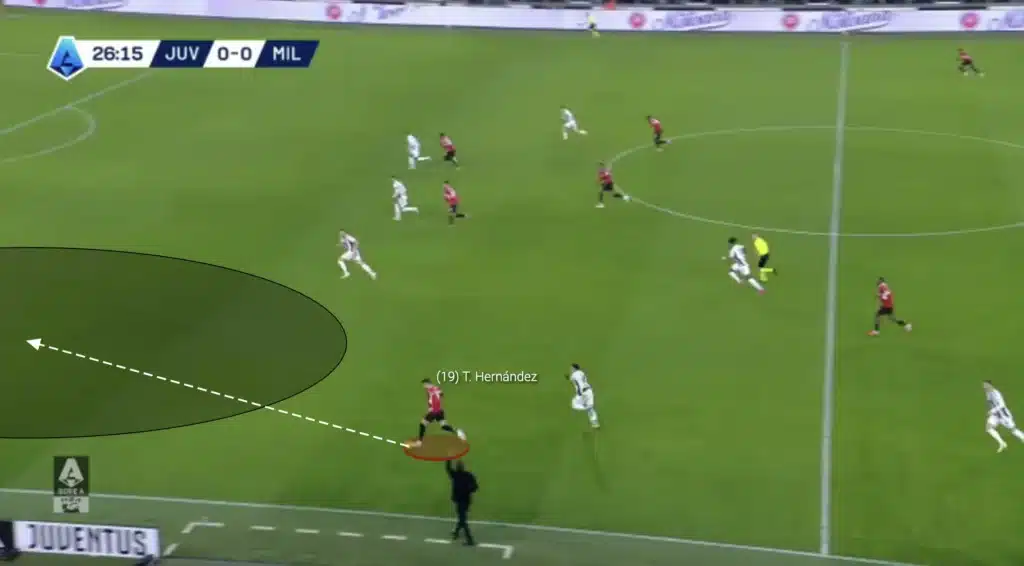
Milan have also exploited this space with midfielders or the striker, who can make runs into this space when the winger inverts.
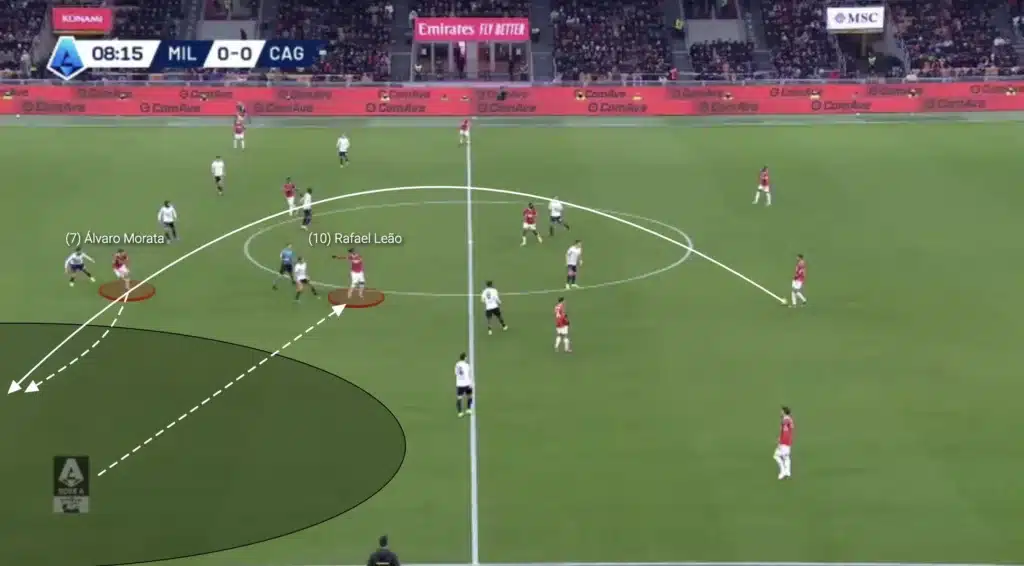
Rotations and Fluidity
The Milan players constantly rotate during the build-up. The team adopts a dynamic approach, shifting between formations to create numerical advantages and exploit spaces. Conceição’s focus is always to get the players into their best positions, where they can make the most out of their individual skills. He emphasizes versatility, with players interchanging positions seamlessly to maintain possession and disrupt the opposition’s defensive structure.
Here, for example, a central midfielder, Yunus Musah, has pushed out to the wing far from his natural position and is playing a pass in behind for a center-back, Fikayo Tomori, who is making a run in behind.
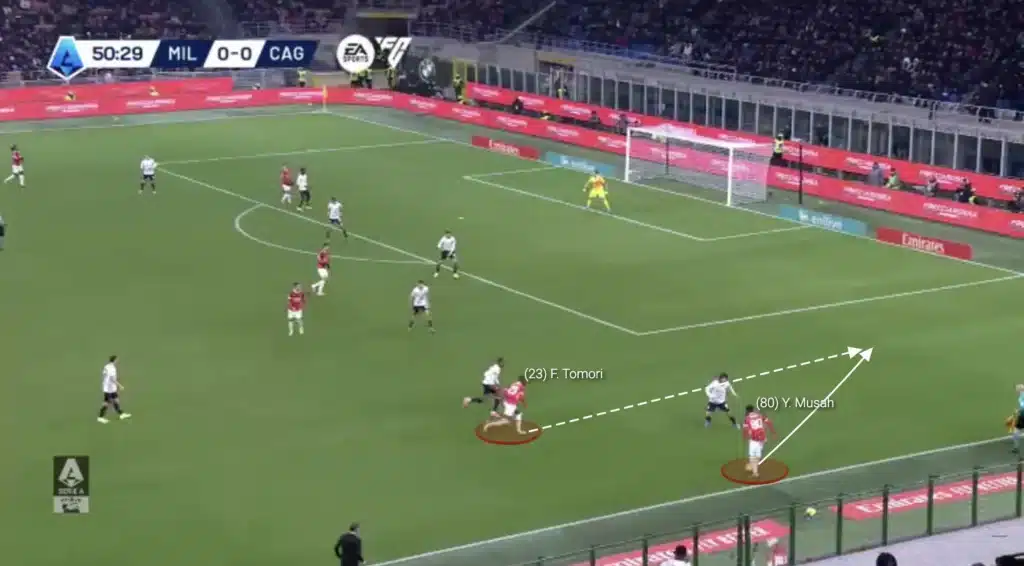
Conceição’s players will also rotate to create new formations and structures in the build-up. Here, for example, a central midfielder drops down between the center-backs. This shift creates a back three, allowing Milan to maintain defensive stability while gaining more control in possession.
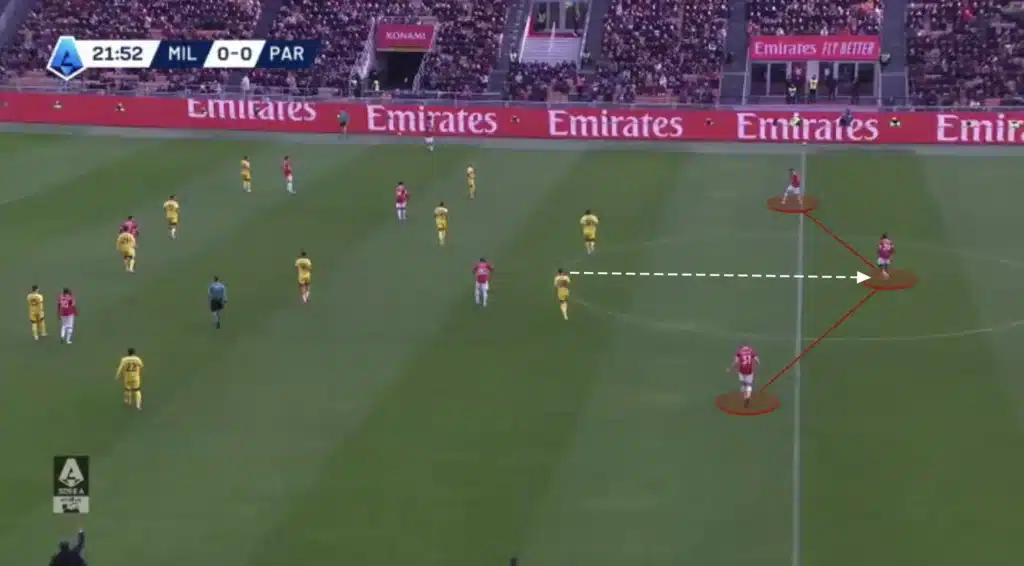
While it demands a lot of technical and tactical skills from the players, this fluidity has created new dynamics for Milan’s attacking style, offering new solutions and ways of beating the opposition’s press. It enhances their ability to control the game while opening up opportunities for incisive passes and creative plays.
Numerical Advantages in the Middle
Milan will often have many players in the center, especially when the wingers invert. This means they will almost always be numerically superior to the opponent in the midfield. Conceição likes this because he prioritizes playing through the middle. He needs one player out wide to pull the opposition apart while the rest create numerical advantages in the midfield areas.
When a team outnumbers the opposition in the midfield, it can more easily retain the ball, exploit spaces, and progress the ball through the center. Milan will often progress the ball through quick central passes between the midfielders, beating the opposition’s press and exploiting gaps in the defense.
Another purpose for keeping many players in the middle is to shorten the distance between them. This shortens the length of the passes, which naturally shortens the time between passes. This means the opposition players will have less time to push up and press, giving the Milan players more time and control.
Rest-Defence
Conceição also wants many players close to the center to create a good rest-defence structure. Rest-defence in football refers to a team’s defensive organization and structure when they have possession of the ball, specifically aimed at being prepared to defend immediately if they lose it. A good rest-defence structure is crucial for maintaining balance and preventing counterattacks when the team is in possession.
Having many players in the middle and close to the ball gives Milan a good rest-defence, since it allows more players to counterpress when they lose the ball. When losing possession, the four or five Milan players closest will immediately jump on the opposition player with the ball and close the distance to cut off any passing lanes. This approach disrupts the opponent’s transition from defense to attack, forcing errors and creating opportunities to regain control of the ball.
Using the Goalkeeper
Sérgio Conceição likes using the goalkeeper in the build-up. The Milan goalkeeper, Mike Maignan, will often push up between the center-backs, giving Conceição’s team an extra man in the build-up phase.
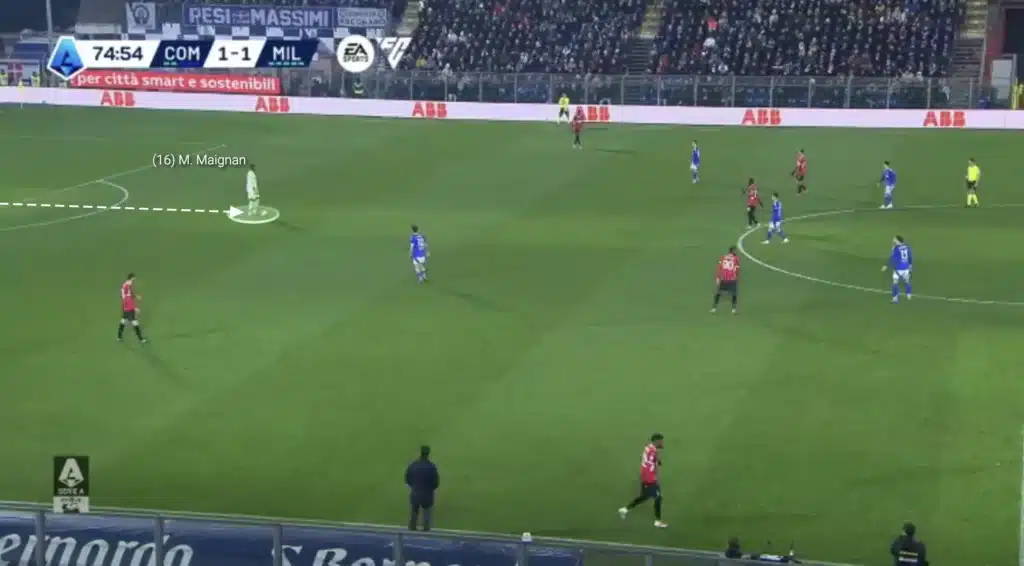
Using the goalkeeper in the build-up phase offers numerous tactical advantages. By involving the goalkeeper, Milan can create numerical superiority at the back, making it easier to evade the opponent’s press and maintain possession. This additional player allows for more passing options, reducing the risk of losing possession and enabling smoother transitions from defense to attack. The goalkeeper can also act as a pivot, switching play across the field to exploit weak points in the opposition’s formation. Furthermore, involving the goalkeeper helps in drawing the opposition forward, creating space higher up the pitch for attackers to exploit.
Balls in Behind
Under Sérgio Conceição, AC Milan have effectively utilized over-the-top through-balls to exploit space behind the opposition’s defense. With a direct and aggressive attacking approach, Milan’s midfielders and defenders look for quick vertical passes over the top, targeting the pace of their forwards making well-timed runs. This tactic has been especially effective against high defensive lines, allowing Milan to bypass opposition pressure and create dangerous goal-scoring opportunities.
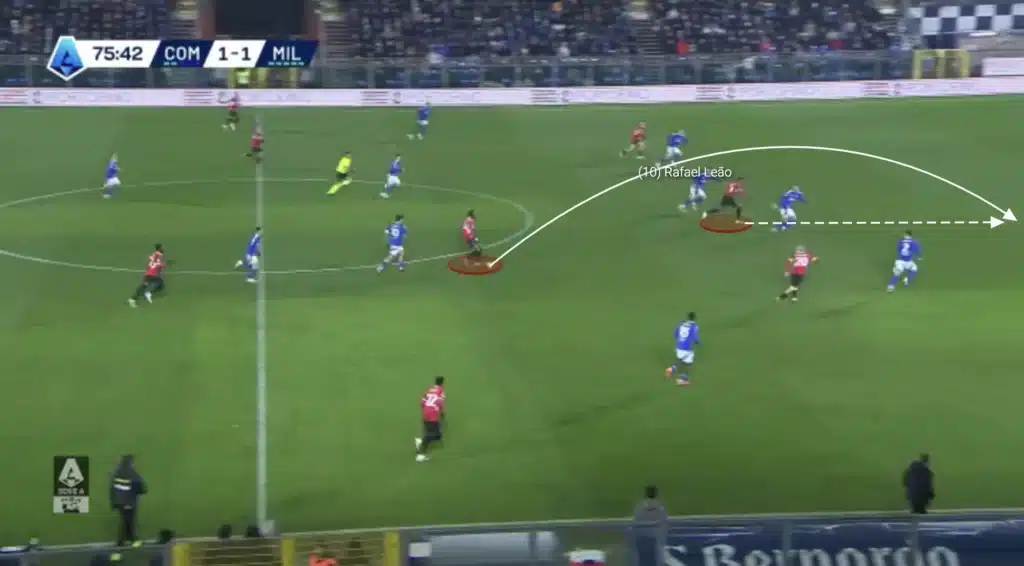
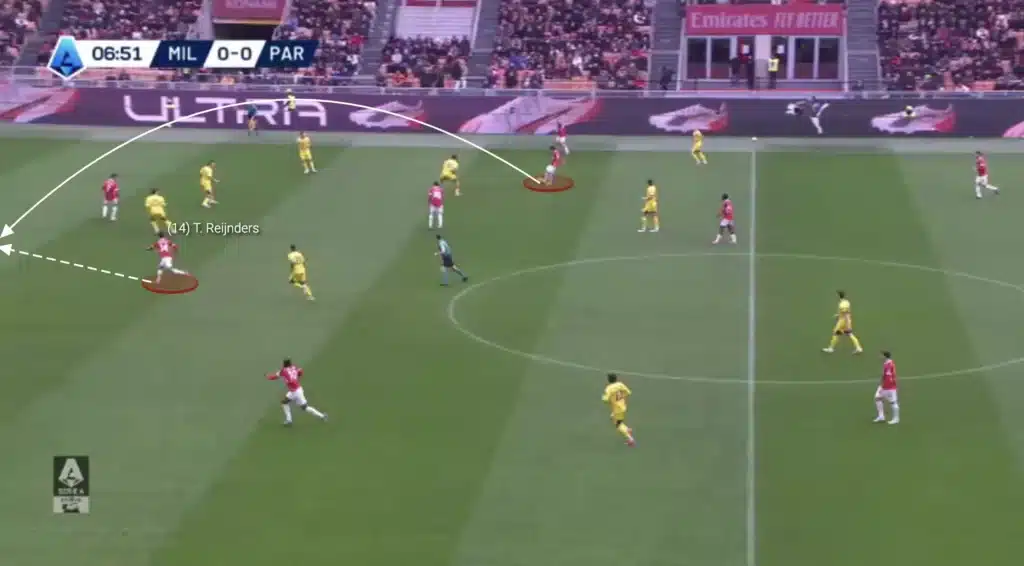
Additionally, this constant threat prevents the opposition from playing with a high backline and closing the space between the lines. Instead, they have to drop the backline and protect the space in behind. This opens the space in front of the backline for the Milan midfielders to exploit.
Counter-Movements
The Milan forwards will also use counter-movements to make it even more difficult for the opposition defenders. When one player makes the run in behind, another one will often drop. This forces the opposition center-backs to make a decision. If they step up on the dropping striker, the space behind them opens up, allowing Milan to play a through-ball to the player who is making the run in behind. However, if they stay in the backline to cover the run, the ball can be played to the dropping striker, who can turn and attack the defense.
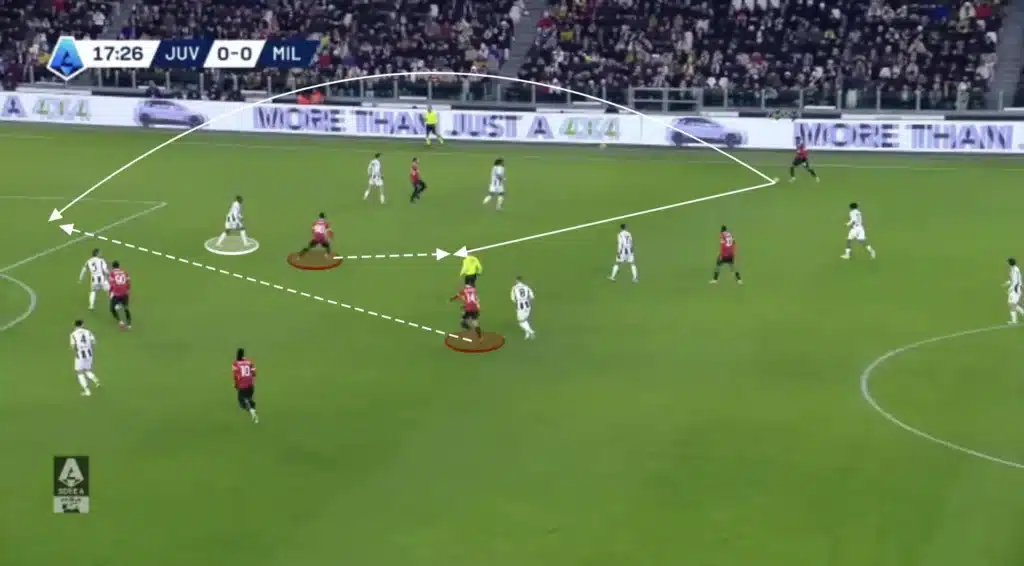
In this situation, the opposition center-back pushes up on the dropping striker, opening the space in behind for the Milan player to receive a through-ball.
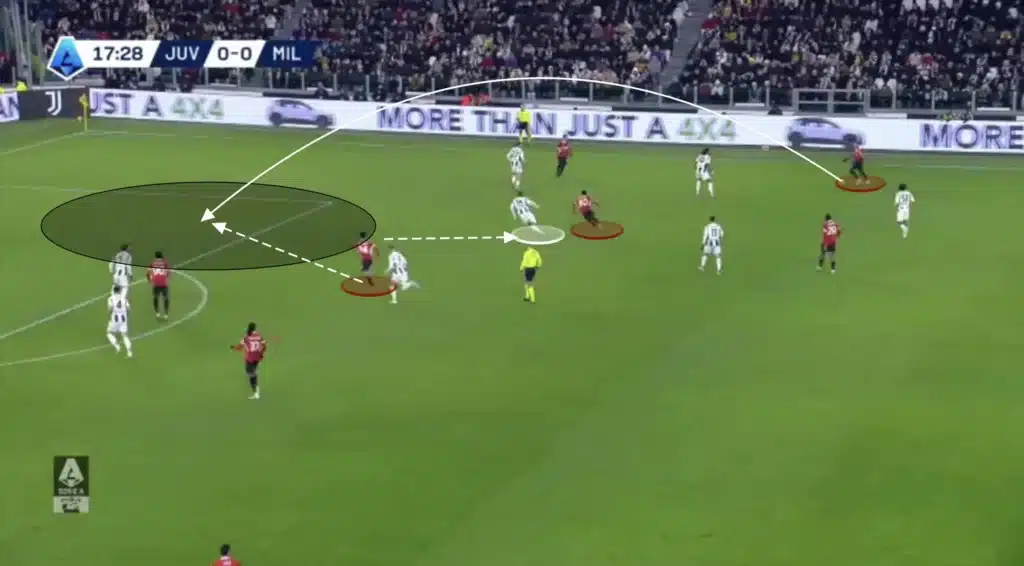
The Milan attackers will use counter-movements like these all the time. When one attacker drops, the other will go in behind, constantly creating questions for the opposition defenders.
Numerical Advantages Against the Opposition’s Defense
Another massive aspect of Milan’s high build-up is their ability to create numerical advantages against the opposition’s defensive line. When the wingers invert and the fullbacks push up, a front five is created, which means the forward line naturally becomes numerically superior against a back four. Conceição’s players are great at taking advantage of this.
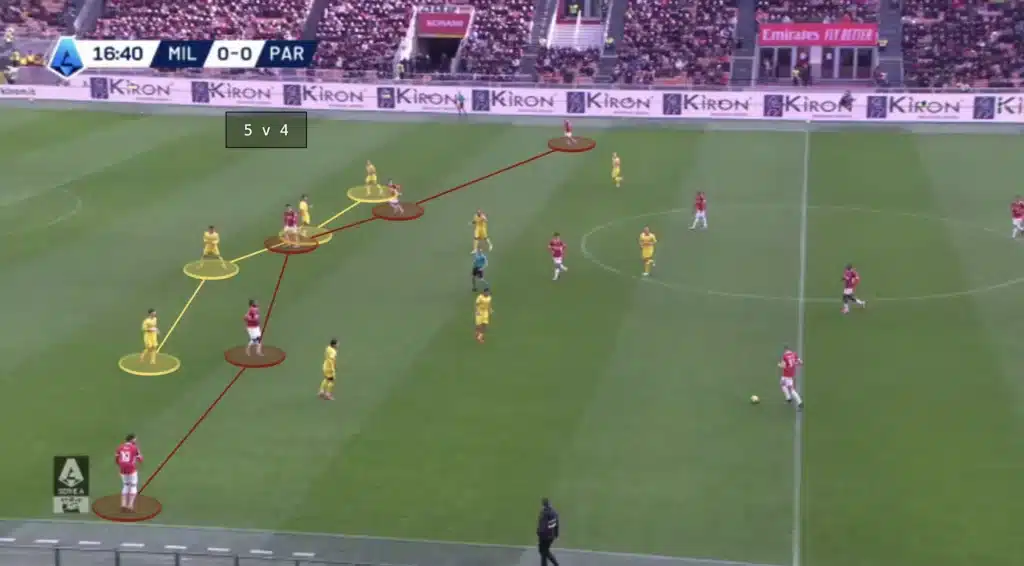
They mainly exploit this overload by creating 2v1 situations against the opposition fullback. When the defending team is positioned on one side, the weak-side fullback becomes vulnerable to the switch of play due to the 1v2 against Milan’s inverted winger and attacking fullback. The defending fullback will often come in to control the winger, leaving space for the Milan fullback out wide. Conceição’s team often capitalizes on this by getting the ball to the fullback and creating many opportunities from 2v1 situations on the wing and in the half-spaces.
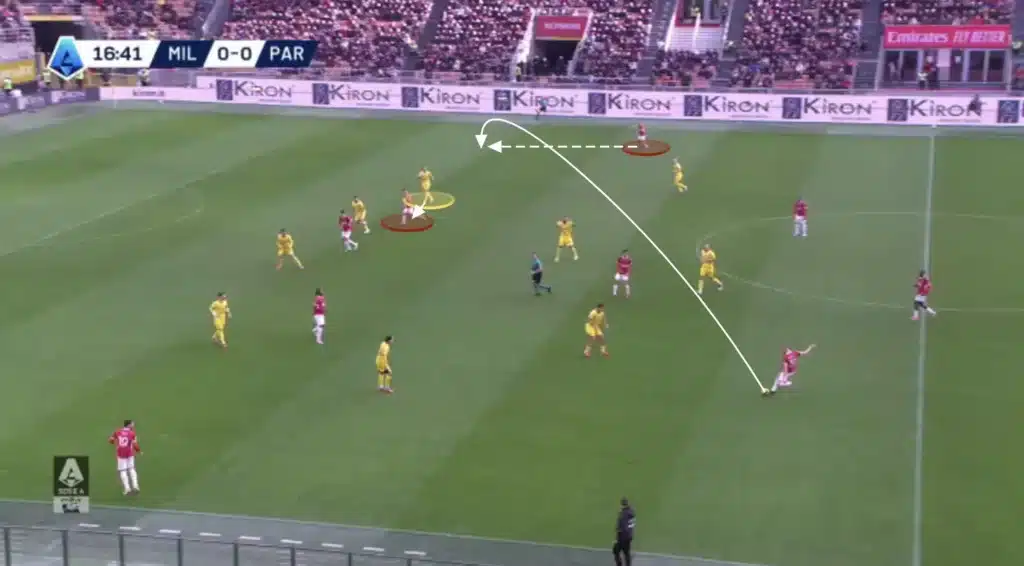
Milan will also exploit this numerical advantage by using counter-movements. When a fullback or center-back has the ball out wide, a central midfielder can make a run in behind while the winger drops. This creates a question for the opposition fullback. If he pushes up on the winger, the space behind him opens up, allowing the Milan center-back to play a through-ball to the running midfielder. However, if he stays inside to cover the run, the ball can be played to the winger, who can turn and attack the defense.
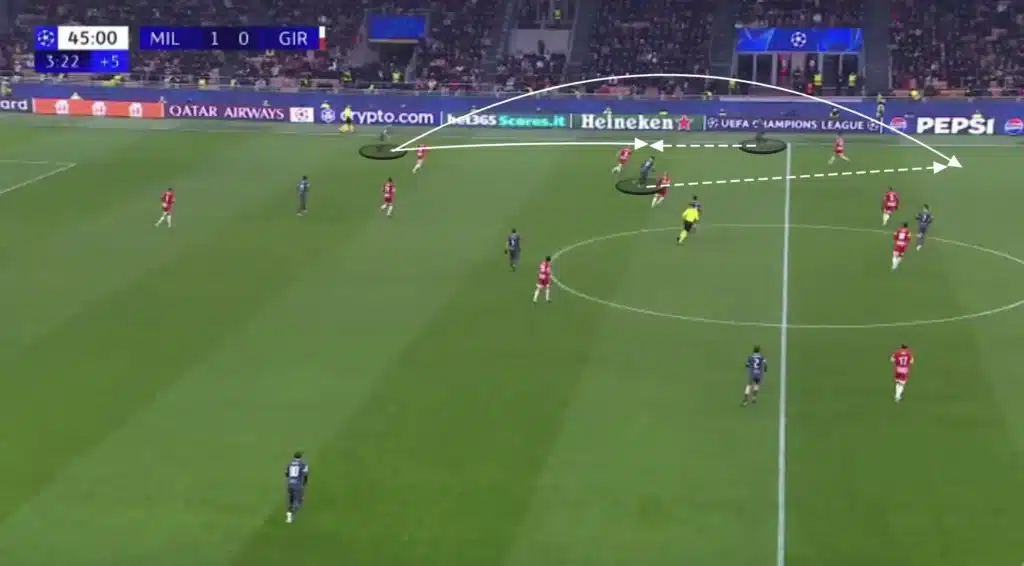
In this situation, for example, the fullback follows the dropping winger, allowing the central midfielder to receive the ball in behind the opposition’s backline.
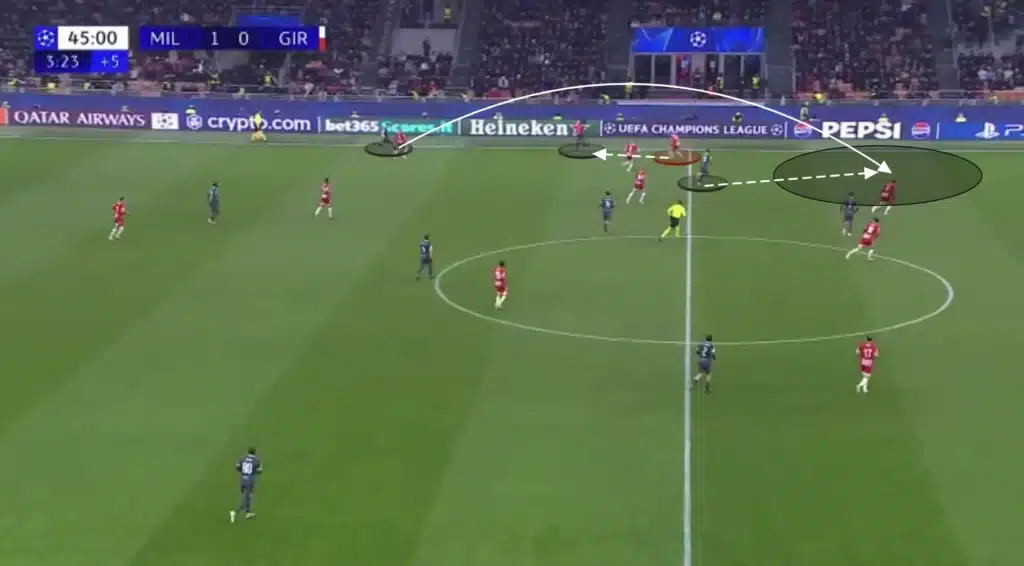
Many Players in the Box
Conceição also emphasizes getting multiple players into the box, creating a chaotic environment for the opposition defenders, and increasing their chances of scoring. The attackers and midfielders look to make aggressive runs into the box when the ball is in the final third, often getting four or five players into these areas to create overloads.
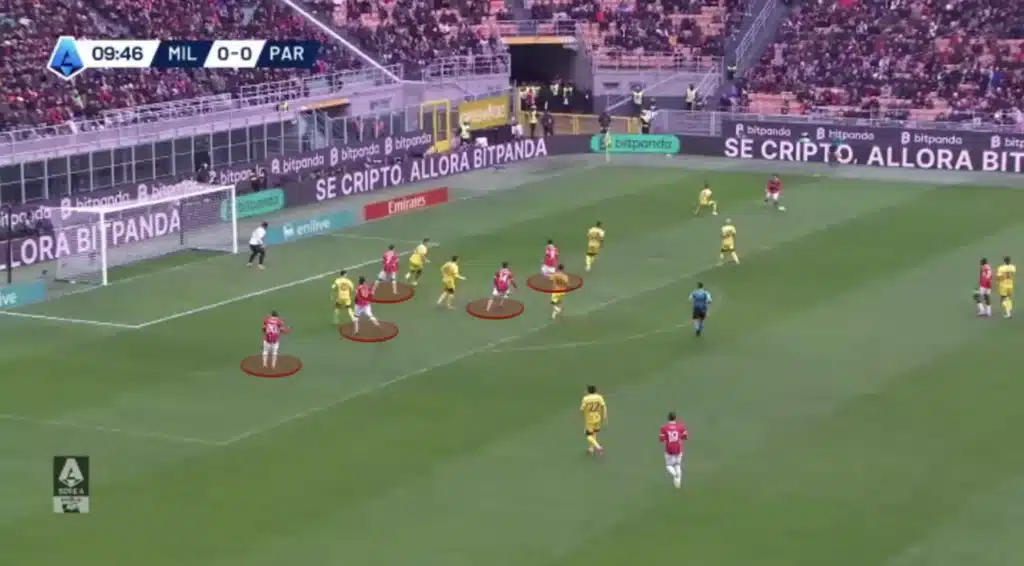
The numerical advantages in the box increase the chances of connecting with the cross, as more players present multiple targets for the crosser, making it harder for defenders to mark everyone effectively. Additionally, having multiple players in the box provides options for different types of finishes, whether it’s a header, volley, or a quick tap-in. It also allows for better positioning to react to second balls or rebounds, increasing the likelihood of capitalizing on any defensive errors.
Conceição also positions many players outside the box, ready for the second balls and cut-backs. Milan will create many crossing opportunities, which pushes down the opposition’s defense and opens the space in front of the opposition’s backline. The central midfielders can collect any loose balls or be found directly in these spaces with cut-backs, and from there, they can shoot or combine with an attacker to create goalscoring opportunities.
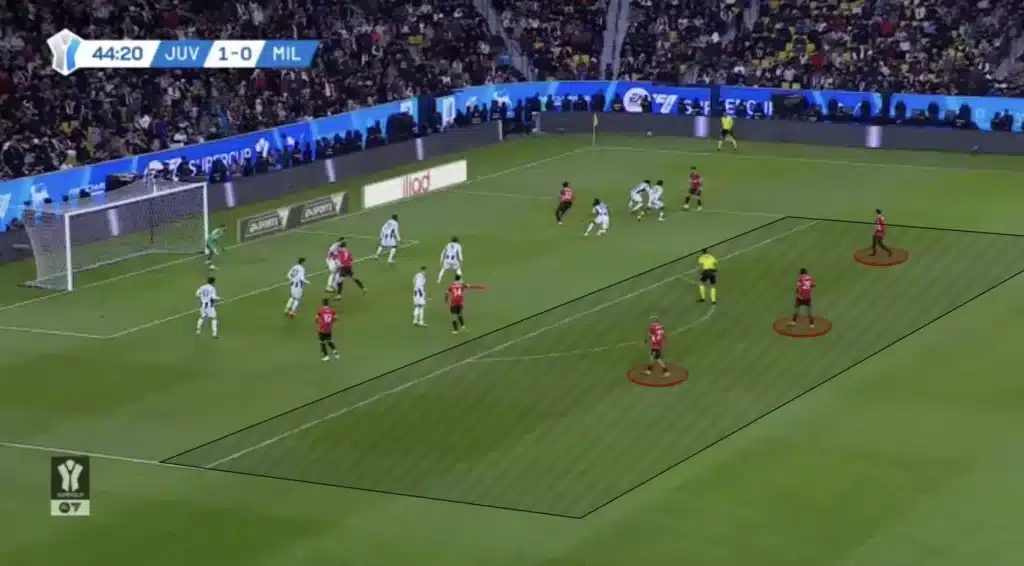
Defending
Milan’s base formation when defending is the 1-4-5-1 formation. They look to set up in a mid-block, always trying to close the center and force the opposition out wide.
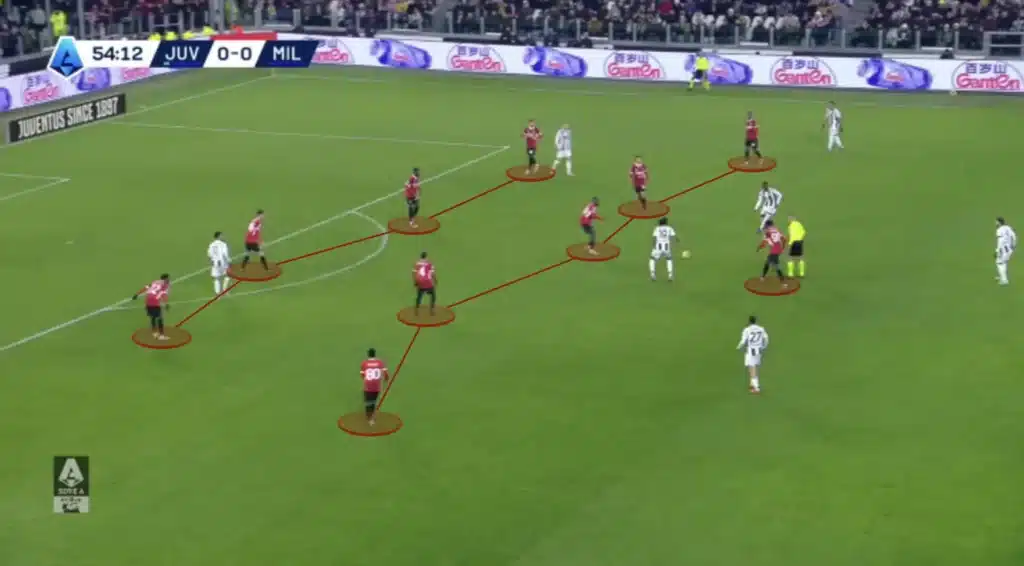
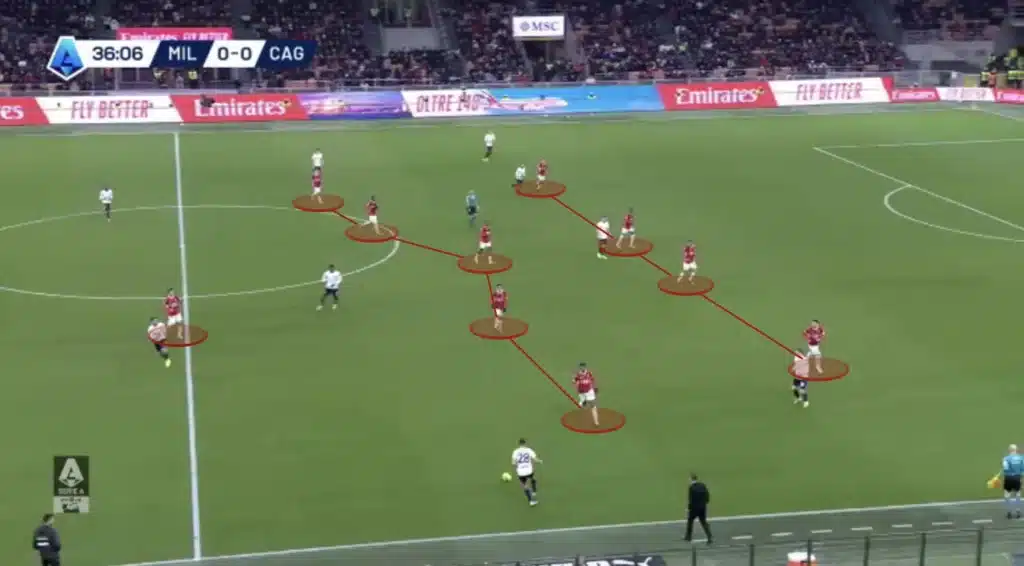
Defending in the 1-4-5-1 formation prioritizes compactness, defensive solidity, and control of central spaces. The midfield five works to close passing lanes, pressing in unison to disrupt the opposition’s build-up while maintaining a disciplined shape. The lone striker applies initial pressure, while the wingers drop deep to form a tight midfield block. This setup forces the opposition wide, where the fullbacks and wingers can engage, limiting dangerous central penetration and ensuring numerical superiority in key defensive zones. Conceição wants his team to stay compact without dropping too low, preferably closing the space between the midfield and backline.
Squeezing the Pitch
To prevent his team from becoming too low when defending, Conceição wants his team to squeeze the pitch. This means constantly pushing the team up as much as possible. Every time the opponent plays a slow, sideways pass or a back pass, Milan’s first line of pressure pushes up, with the rest of the team following to stay compact. When the next pass comes, they push up even more, forcing the opponent back even more.
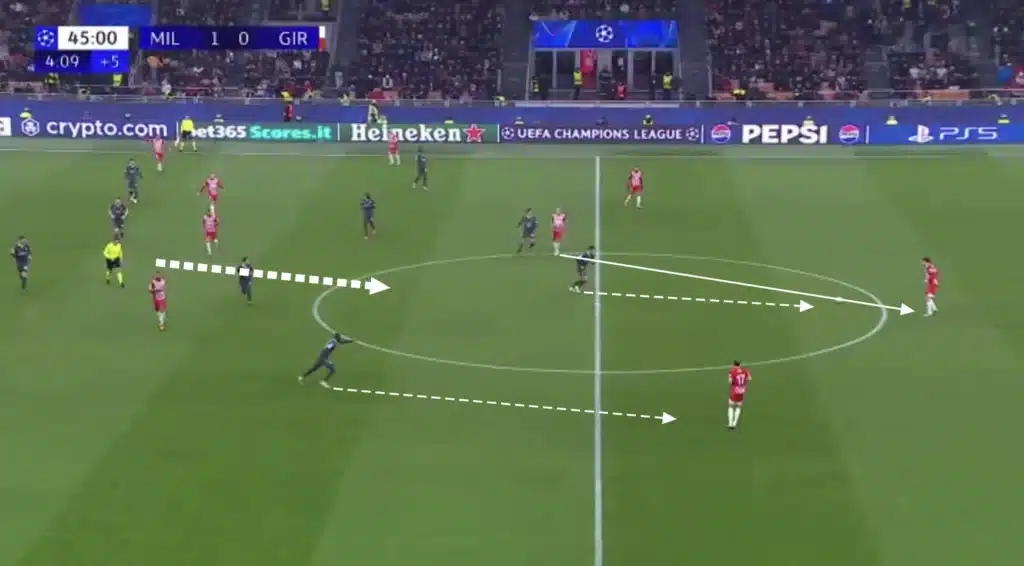
This approach keeps opponents under constant pressure, making it difficult for them to build rhythm or find space between the lines. It also pushes the opponent further away from the AC Milan goal, making it harder to create chances.
High Backline (Def)
Conceição values compactness when defending and, therefore, wants Milan to defend with a high backline, making the space from the backline to the midfield line as small as possible. Defending with a high backline involves positioning the defensive line closer to the midfield rather than near the goalkeeper. This tactic compresses the space available for the opposing team to operate, disrupting their build-up play and increasing the chances of winning the ball back quickly.
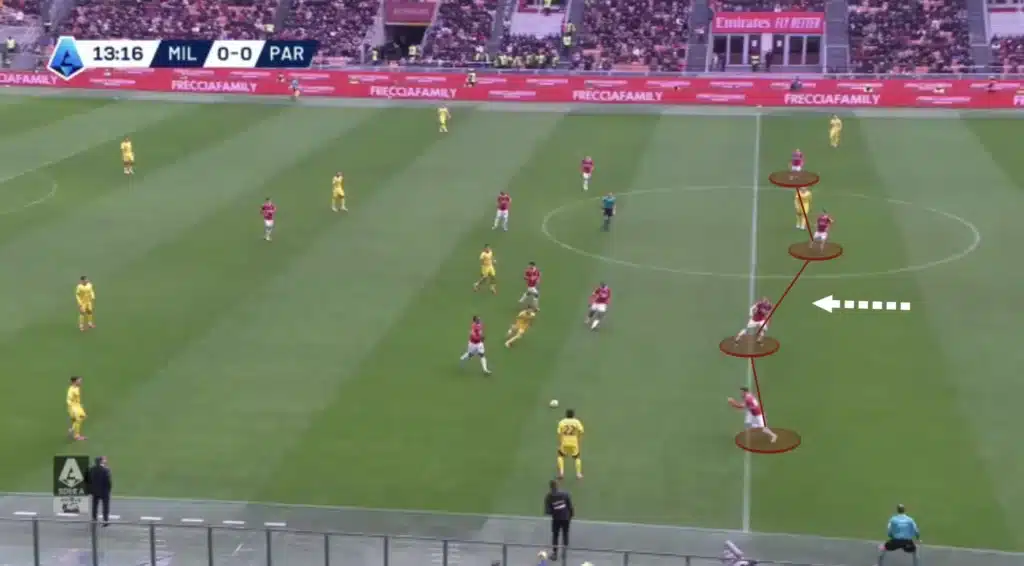
A high backline also allows defenders to support the midfield more effectively, creating numerical superiority in central areas and facilitating quicker transitions from defense to attack. However, it requires defenders with good pace and positional awareness to deal with long balls and prevent opposing attackers from exploiting the space behind.
Additionally, everyone must be in the same line when defending with a high backline to maintain an effective offside trap, ensure cohesive coverage, and reduce gaps that attackers can exploit. A well-aligned defensive line makes it easier to catch opposing forwards offside, preventing them from receiving the ball in dangerous positions.
Work Rate
Since Sérgio Conceição’s arrival, AC Milan’s defensive work rate has been outstanding. His high-intensity philosophy demands relentless pressing and disciplined team shape, and the players have embraced it with full commitment. The wingers and midfielders track back tirelessly, ensuring compactness and closing down passing lanes, while the striker leads the press from the front. Milan’s ability to quickly recover their defensive shape after losing possession has made them far more difficult to break down, forcing opponents into wide areas and low-quality attacking positions. This collective effort has been crucial in making Milan a more resilient and aggressive defensive unit under Conceição.
High Press
Conceição also implements a high-pressing system designed to disrupt the opposition’s build-up and force turnovers in dangerous areas. Their pressing structure will depend on the opposition, but they usually press in an aggressive man-to-man system. Each player is assigned a direct opponent to mark tightly, ensuring no easy passing options are available.
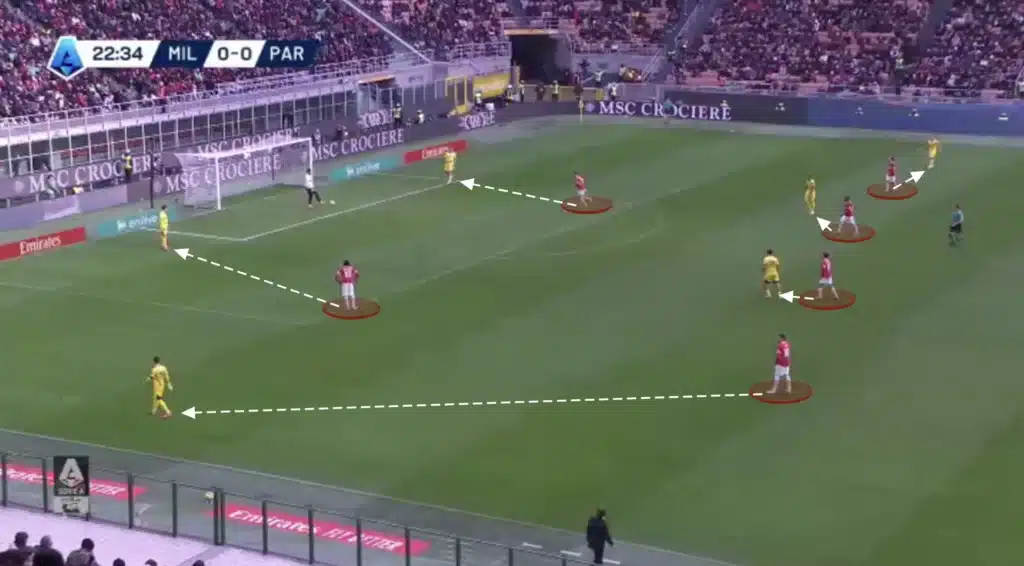
This intense pressure forces the opposing team into hurried decisions, often resulting in turnovers in dangerous areas. Milan almost use this high press as an attacking threat, scoring many goals from winning the ball high up the pitch.
In a man-to-man system, it becomes crucial that the players know when to mark the opponent they are responsible for and when not to. If an opponent, for example, is very far from the ball, the Milan player marking him does not need to be as close to him. He can instead come in and help create numerical superiorities in the center, decreasing the risk of dangerous 1v1 situations.
The Milan players will always have an opposition player they are responsible for. However, they will never be closer to them than they need to be. A rule of thumb for the players could be that the closer you are to the ball, the closer you need to be to your opponent. The further away you are from the ball, the further away you can be from your opponent.
Counterattacks
Under Sérgio Conceição, AC Milan have become a lethal counterattacking side, using their defensive solidity as a platform for rapid offensive transitions. As soon as possession is won, the team looks to break forward with speed and precision, exploiting gaps left by the opposition. The wingers and fullbacks provide immediate width, while the midfielders drive forward to support the lone striker. Conceição’s emphasis on verticality ensures that Milan attack with purpose, minimizing unnecessary passes and maximizing direct, goal-threatening movements. This aggressive transition play has made them a constant danger on the break, punishing teams that commit too many players forward.
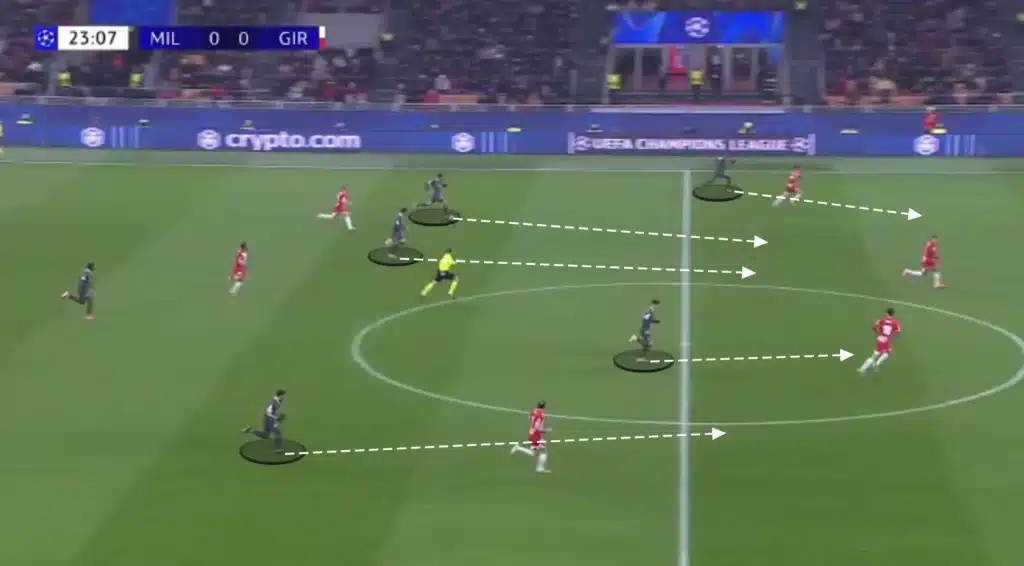
Final Thoughts
Sérgio Conceição’s arrival at AC Milan marks a significant shift in the club’s tactical approach. His high-intensity pressing, defensive organization, and fast-paced attacking transitions will demand a great deal from the players, both physically and mentally. However, if successfully implemented, his philosophy could bring Milan greater defensive solidity and a more aggressive, dynamic presence in Serie A and Europe.
The challenge will be adapting his methods to a new league, maximizing the strengths of Milan’s squad, and ensuring consistency over a long season. If he can strike the right balance, Conceição has the potential to make the Rossoneri a force to be reckoned with once again. His tenure at Porto proved his ability to compete with bigger budgets and tactically outmaneuver opponents—qualities that could serve Milan well in their pursuit of success.
Ultimately, his success will depend on how quickly the squad adapts to his demanding system and whether Milan can provide the right reinforcements to fit his style. One thing is certain: under Conceição, AC Milan will be a team that plays with intensity, discipline, and an unwavering fighting spirit.

Very good and clear analysis! Easily explained for everyone new to football as well, keep it up!